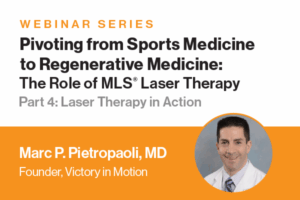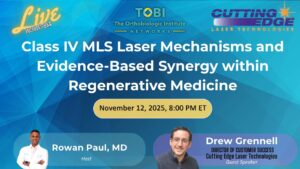With high rates of opioid misuse among professional football players, it’s important to investigate how MLS Laser Therapy can help athletes decrease their reliance on opioids to improve care when recovering from injuries.
Opioid Misuse
Misuse of opioids is an unfortunately common issue in the NFL, which could lead to lifelong consequences such as addiction and other health concerns that impact quality of life. A survey of 644 retired NFL players found that 52% used opioids during their career, with 71% reporting that they misused opioids. 15% of those players who misused opioids during their career reported continued misuse after they retired.[i]
Due to the nature of their sport, NFL players are at a particularly high risk for serious injury. Data indicates that 68% of players could be injured each year.[ii] The most common injuries reported by players in this study were knee injuries, followed by shoulder or back injuries.[iii] Injured players are often rushed back to the field without sufficient time to heal, putting these athletes at higher risk to reinjure themselves, leading to more consistent opioid use throughout their career. This study concluded that professional athletes need to guard against misuse of opioids prescribed due to injuries during their career.[iv]
Nonpharmacological Alternatives
With acknowledgements from the Centers for Disease Control and Prevention and the American Academy of Orthopaedic Surgeons as a viable alternative to prescription pain killers, laser therapy is growing in popularity in sports medicine for a wide range of conditions, including these commonly seen in football:
- Sprains / Strains
- Knee / Joint Injuries
- Achilles tendonitis
- Plantar Fasciitis
- Epicondylitis / Overuse injuries
- Wounds / Contusions
MLS Laser Therapy is ideal for addressing sports related injuries because MLS Laser Therapy: reduces pain upon application, can be applied immediately after an injury occurs, speeds up recovery, and delivers long lasting results.[v]
Stacey A. Paukovitz, DPM, MA, FACFAS, of High Performance Foot + Ankle Podiatric Medicine and Surgery in New Jersey uses MLS Laser therapy to help athletes recover saying, “we have a large athletic patient population with overuse injuries, which we find the laser extremely beneficial.”
MLS Laser Therapy and Athletes
Josef J. Geldwert, DPM says that MLS Laser Therapy is particularly effective for treating acute injuries such as ankle sprains saying, “This [MLS Laser Therapy] is a great modality to use in those cases because it is pain free and quickly reduces the swelling. I have even treated patients with fractures to reduce the swelling caused as a result of the break.”[vi]
A key component to treating football players is the need for a quick return to the field. MLS Laser Therapy can help decrease healing time, allowing athletes to return to activities quickly.[vii] Dr. Gibson says, “I am finding this treatment very valuable for athletes that have a short window for return to full activities and am shortening recovery times from these injuries.”
MLS Laser Therapy is an FDA-cleared, nonpharmacological, and noninvasive pain management solution that can help decrease the use, and therefore misuse, of opioids in NFL players. The Multiwave Locked System® (MLS) is a unique type of Class IV laser technology that utilizes a patented emission system to precisely synchronize two wavelengths, 808nm and 905nm to create anti-inflammatory and analgesic effects. MLS is a Class IV Laser designed to optimize the safety of a Class IIIB Laser with the efficiency and results of a Class IV Laser. The MLS Therapy Laser can penetrate 3-5 cm deep without generating heat, efficiently reducing pain and inflammation while minimizing the risk of thermal damage often associated with other Class IV Lasers.
As a viable, nonpharmacological modality, MLS Laser Therapy can help reduce pain and inflammation associated with common football injuries, helping players get back on the field quickly while minimizing the use of opioids and other prescription pain relivers.
References:
[i] Cottlet, Linda B., Arbi Ben Adballah, Simone M. Cummings, John Barr, Rayna Banks, and Ronnie Forchheimer. “Injury, Pain, and Prescription Opioid Use Among Former National Football League (NFL) Players.” National Library of Medicine. Last modified July 2011. https://www.in.gov/health/overdose-prevention/files/Cottler-et-al-TBI-and-Opioid-Misue-in-Professional-Athletes.pdf.
[ii] “Injury, Pain, and Prescription Opioid Use Among Former National Football League (NFL) Players.” National Library of Medicine.
[iii] “Injury, Pain, and Prescription Opioid Use Among Former National Football League (NFL) Players.” National Library of Medicine.
[iv] “Injury, Pain, and Prescription Opioid Use Among Former National Football League (NFL) Players.” National Library of Medicine.
[v] “MLS Laser: #1 Choice for Sports Injuries for Professional And Amateur Athletes.” Heal With Laser. https://www.healwithlaser.com.au/blog/blog202204/.
[vi] Geldwert, Josef J. “Getting My Patients Back in the Game with MLS Laser Therapy.” Cutting Edge Laser Technologies. https://celasers.com/knowledge-center/getting-my-patients-back-in-the-game-with-mls-laser-therapy.
[vii] “MLS Laser: A Faster Way to Get Back On The Field.” Colorado Center for Podiatric Sports Medicine. Last modified March 14, 2019. https://dryakel.com/blog/mls-laser-a-faster-way-to-get-back-on-the-field/.



